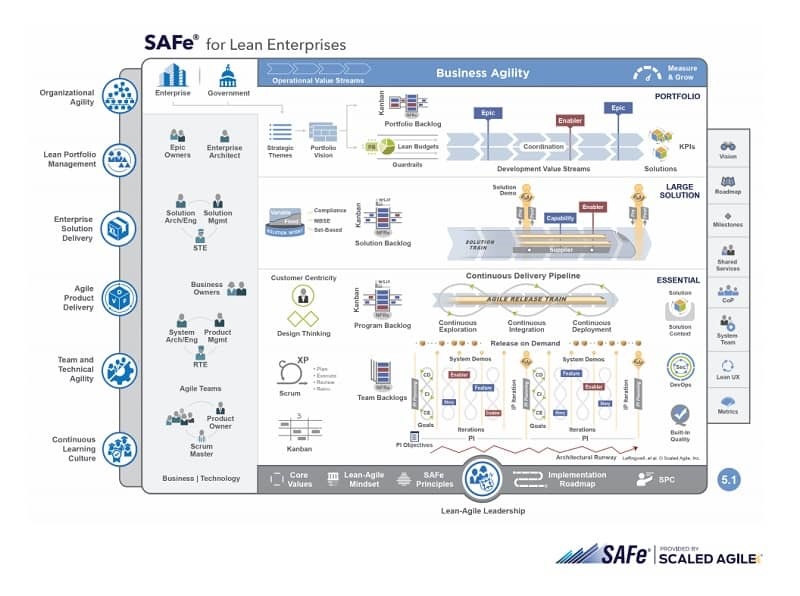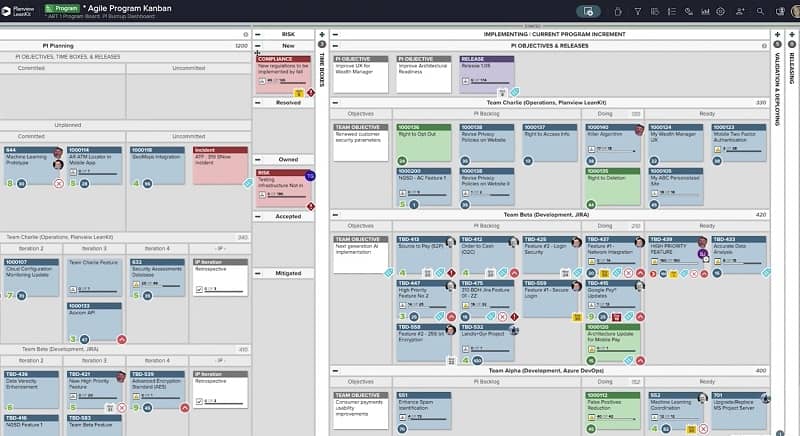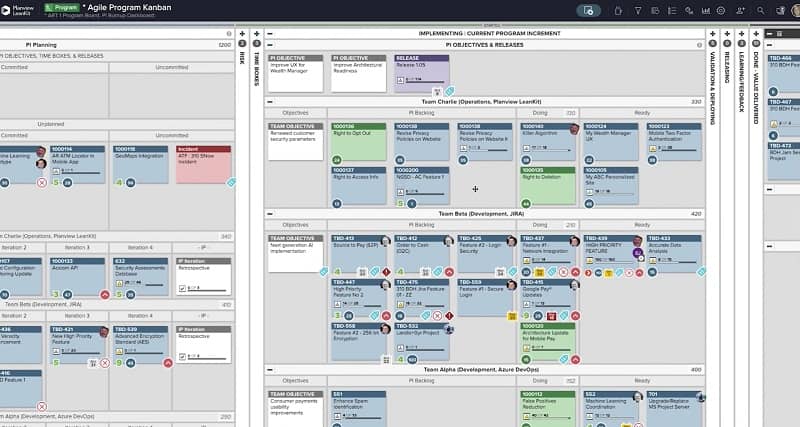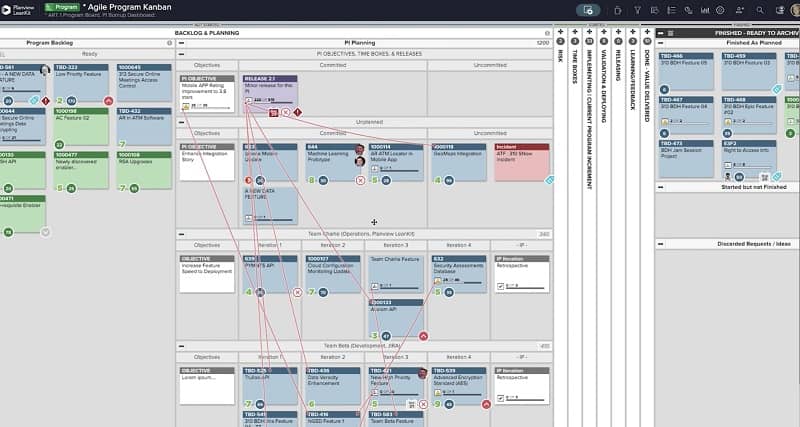Table of contents
What is the Scaled Agile Framework?
The Scaled Agile Framework® (SAFe ®) is a set of practices and workflow patterns that provides guidance to organizations seeking to practice Agile at enterprise scale. SAFe helps organizations to take the efficiency-boosting, collaborative tenets of Lean and Agile and apply them to a more complex organizational system.
Taming the Agile Chaos with Agile Program Management: How Planview supports Essential SAFe
Watch the solution demo • Taming the Agile Chaos with Agile Program ManagementHow to Identify Your Value Streams
View the eBook • How to Identify Your Value Streams
SAFe is the most widely recognized framework for scaling Agile, but it is not the only one: other frameworks for practicing Agile at scale include Large Scale Scrum (LeSS) and Disciplined Agile (DA).
Practicing Agile at scale is not without its challenges: Critics of the SAFe framework cite frustration with its overly complicated and hierarchical approach. However, many others find immense value in the structure and discipline of the Scaled Agile Framework. Through SAFe, organizations around the globe have been able to speed up time to market, improve collaboration, reduce risk, and operate with greater efficiency and transparency.
Scaled Agile Framework Principles
1. Align around an economic perspective. Use SAFe to align team members with the financial objectives of the organization.
2. Practice systems thinking. Apply systems thinking to all decision-making to ensure that decisions are being made holistically and in alignment with organizational goals.
3. Manage variability; preserve options. To boost agility while minimizing risk, work to manage variability. Use set-based design to preserve options for as long as possible without increasing risk.
4. Build incrementally with fast integrated learning cycles. Use short feedback loops to quickly gather information and make swift, informed decisions.
5. Base milestones on objective evaluation of working systems. Build integration points between increments to establish the technical viability, usability, or success of a project before moving forward.
6. Visualize and limit work-in-progress, reduce batch sizes, and manage queue lengths. Improve speed and focus by proactively limiting how much work is in the system at any given time.
7. Apply cadence (timing), synchronize with cross-domain planning. Follow a shared rhythm of planning and executing work so that cross-functional teams can synchronize their efforts and pivot together.
8. Unlock the intrinsic motivation of knowledge workers. Create an environment that allows team members to experience autonomy, mastery, and purpose in their daily work. Encourage candid feedback, healthy conflict, and continuous learning.
9. Decentralize decision making. Decentralize non-strategic decision-making to improve flow, boost speed, and encourage autonomy throughout the organization.
Learn more about these nine principles in greater detail.
What is the History of SAFe?
The Scaled Agile Framework is one of several frameworks for scaling Agile that emerged in the early 2000s. At that point, Agile software development had been around for over a decade, and was proving to be a successful way to deliver higher-quality software at a faster and more predictable pace.
However, organizations were struggling to reconcile the operational and structural differences between Agile teams and the rest of the organization. Traditional methods for budgeting, planning, and executing work were not aligning with the way Agile teams were working.
In 2011, software industry veteran Dean Leffingwell launched what we now know as the Scaled Agile Framework, originally calling it the “Agile Enterprise Big Picture.” Leffingwell explained how existing Agile frameworks (including Lean, Kanban, Scrum, and XP) could fit into the organization’s “Big Picture:” at the Team, Program, and Portfolio level.
What is SAFe 5?
As SAFe has been applied in various industries through the years, it has been updated to meet the challenges of an increasingly digital age. SAFe 5, originally released in January 2020, includes four configurations: Essential SAFe, Large Solution SAFe, Portfolio SAFe, and Full SAFe.

Each of these configurations is designed to allow organizations to apply the framework to meet their needs for enterprise agility: Essential SAFe is the most basic building block, designed for organizations that might have a single Agile Release Train (ART, or Agile Team of Teams) – a team made up of multiple Agile teams working toward the same shared goal.
On the other end of the spectrum of the Scaled Agile Framework, Full SAFe is the most comprehensive configuration of SAFe, intended for delivering large, integrated solutions that require the work of hundreds of people and dozens of teams to develop and maintain.
Posters showing the different configurations of the SAFe Big Picture are available for download from Scaled Agile Inc.
Essential SAFe
The Essential SAFe configuration is as it sounds: A bare-bones version of SAFe, that contains the minimal set of roles, events, and artifacts required to continuously deliver solutions via an Agile Release Train.
Large Solution SAFe
The Large Solution SAFe configuration is for solutions that are large and complex but do not require the portfolio management capabilities of Portfolio or Full SAFe.
Portfolio SAFe
Portfolio SAFe adds the portfolio management capabilities to align strategy with execution, usually for one or more value streams.
Full SAFe
The most comprehensive configuration of SAFe, Full SAFe includes all seven core competencies needed for business agility.
Lean Enterprises and SAFe
SAFe 4.6 introduced us to the five competencies of the Lean enterprise. The release of SAFe 5 added two more competencies: organizational agility and continuous learning.
Working to grow in each of these core competencies is a proven path toward a scaled Agile enterprise.
Three of the core competencies (Lean-Agile leadership, team and technical agility, and Agile product delivery) are part of every configuration of the Scaled Agile Framework, including Essential SAFe.
Lean-Agile leadership
It’s unsurprising that disciplined Lean-Agile leadership is a core competency of a Lean enterprise. Lean-Agile leaders are called to demonstrate Lean-Agile thinking, ensure strategic alignment, remove impediments to flow, and empower teams to be their best.

Team and technical agility
Technical and team agility refers to the practices, principles, roles, and artifacts that enable teams to operate efficiently and pivot swiftly. You cannot have organizational agility without technical and team agility.
Agile product delivery
Agile product delivery – a customer-centric approach to defining, building, and releasing valuable products and services in a continuous flow – is another core competency seen in every configuration of the Scaled Agile Framework. A key component of Agile product delivery is developing on cadence and releasing on demand.
Enterprise solution delivery
Enterprise solution delivery is the application of Lean-Agile practices and principles to the development of complex applications, networks, and cyber-physical systems. It is included in the Large Solutions, Portfolio, and Full SAFe configurations.
Lean portfolio management
Lean Portfolio Management, or LPM, is the application of Lean-Agile thinking to the way projects are planned, funded, and executed, specifically: Strategy and investment funding, Agile portfolio operations, and Lean governance. LPM is included in the Portfolio and Full SAFe configurations.
Organizational agility
With the release of SAFe 5, the Scaled Agile Framework expanded to include organizational agility as a core competency in the Portfolio and Full SAFe configurations. SAFe describes three components of organizational agility: Lean-thinking people and Agile teams, Lean business operations, and strategic agility.
Continuous learning
The final core competency is a culture of continuous learning, which is included in the Portfolio and Full SAFe configurations. The three dimensions of a continuous learning culture are becoming a learning organization, encouraging innovation, and having a relentless commitment to improvement.
You can learn more about the seven core competencies of the Lean enterprise here.
Scaled Agile Framework Challenges
Scaling Agile is an inherently complex process – that’s why there are frameworks designed to guide organizations through it! Although many organizations have had great success with SAFe, here are two of the most common challenges or criticisms of the framework that organizations encounter.
Hierarchical structure
One of the criticisms of the Scaled Agile Framework is that it encourages a hierarchical, or top-down, organizational structure, which is a deviation from what is typically considered Lean-Agile thinking. Typically, Lean-Agile thinking aligns with a flatter organizational structure, encouraging autonomous leadership throughout the organization. However:
Proponents of SAFe argue that centralizing strategic decision making at the top enables organizations to maintain strategic alignment, which is often a challenge for Agile teams.
Overly complicated
Another criticism, or challenge, that organizations experience when adopting SAFe is that it is too complicated – that the roles, practices, artifacts, and rituals of SAFe are too heavy of a ‘lift’ for organizations who might not be fully committed to scaling Agile across the entire solution.
This article includes a more complete list of challenges with the SAFe framework.
Scaled Agile Framework Benefits
Of course, for organizations who are able to overcome the challenges associated with scaling Agile with SAFe, there are many benefits: Faster time to market, better strategic alignment, accelerated feedback loops, better cross-functional collaboration, and greater transparency, to name a few.
Faster time to market
Increasing time to market is usually one of the main motivating factors for scaling Agile, because it can be such a differentiator in a competitive space.
Organizations see how Agile teams are able to deliver solutions quickly, and want to replicate that at a greater scale. With shorter planning cycles, and more adaptive governance and funding practices, SAFe provides organizations with a framework for increasing speed to market at scale.

Strategic alignment
Strategic alignment – getting (and keeping) everyone on the same page – is difficult enough for just one team, let alone an entire organization. The Scaled Agile Framework guides organizations through the process of organizing teams (or ARTs) around value streams and then creating communication workflows that enable strategic alignment at scale.
Accelerated feedback loops
Faster feedback means faster delivery – which is why accelerating feedback loops is often a goal for Agile organizations. SAFe has built-in quality practices at every level, and encourages teams to get feedback early and often. These structures enable organizations practicing SAFe to gather the information they need to make informed decisions and deliver quality work quickly.
Better cross-functional collaboration
Effective cross-functional collaboration is necessary for organizational agility – but it’s easier said than done. SAFe guides organizations through the process of identifying value streams, aligning teams around shared goals, and opening up lines of communication between cross-functional groups.

Greater transparency
Last, but certainly not least, SAFe enables organizations to operate with greater transparency. SAFe allows everyone in the organization to understand the “Big Picture,” and how their work fits into the organization’s larger strategic goals. Through a predictable cadence of planning and executing work, SAFe helps organizations operate with greater transparency and accountability than ever before.
Scaled Agile Framework Training
Adopting SAFe as an organization is no small feat. It’s important that everyone operates with a common language, and from the same foundation of SAFe principles.
This is why it can be immensely helpful to conduct formal SAFe training in your organization. SAFe training can jumpstart your organization’s implementation of SAFe and help to minimize confusion and frustration around SAFe terms, practices, and principles.
Virtual and in-person SAFe training can be found online for individuals, teams, leaders, or entire enterprises. The Scaled Agile Framework organization also has free educational materials available on their website for additional training.
Scaled Agile Framework Certifications
In addition to general SAFe training and education, many organizations encourage their employees to pursue certifications specific to their role. SAFe certifications are available for each of the SAFe roles (such as Scrum Master, Product Owner, Architect, Solutions Engineer, etc.) through Scaled Agile, Inc.
Pursuing these role-specific certifications helps individuals build confidence in their roles, while also helping to increase Agile maturity in the teams they work with.
Scaled Agile Framework
Many organizations around the world find themselves wanting to replicate the success of their Agile teams at enterprise scale. Scaling Agile presents some not-so-insignificant challenges, such as adapting planning and funding practices to meet the needs of Agile teams, and evolving leadership to lead cross-functional teams to success.
The Scaled Agile Framework is the most popular framework for applying Agile practices at scale. SAFe 5 offers four configurations based on the size of your SAFe implementation: Whether you’re trying to adapt SAFe with just one ART, or the entire organization, SAFe can provide the structure, practices, and tools necessary to lead your Agile teams to success.
